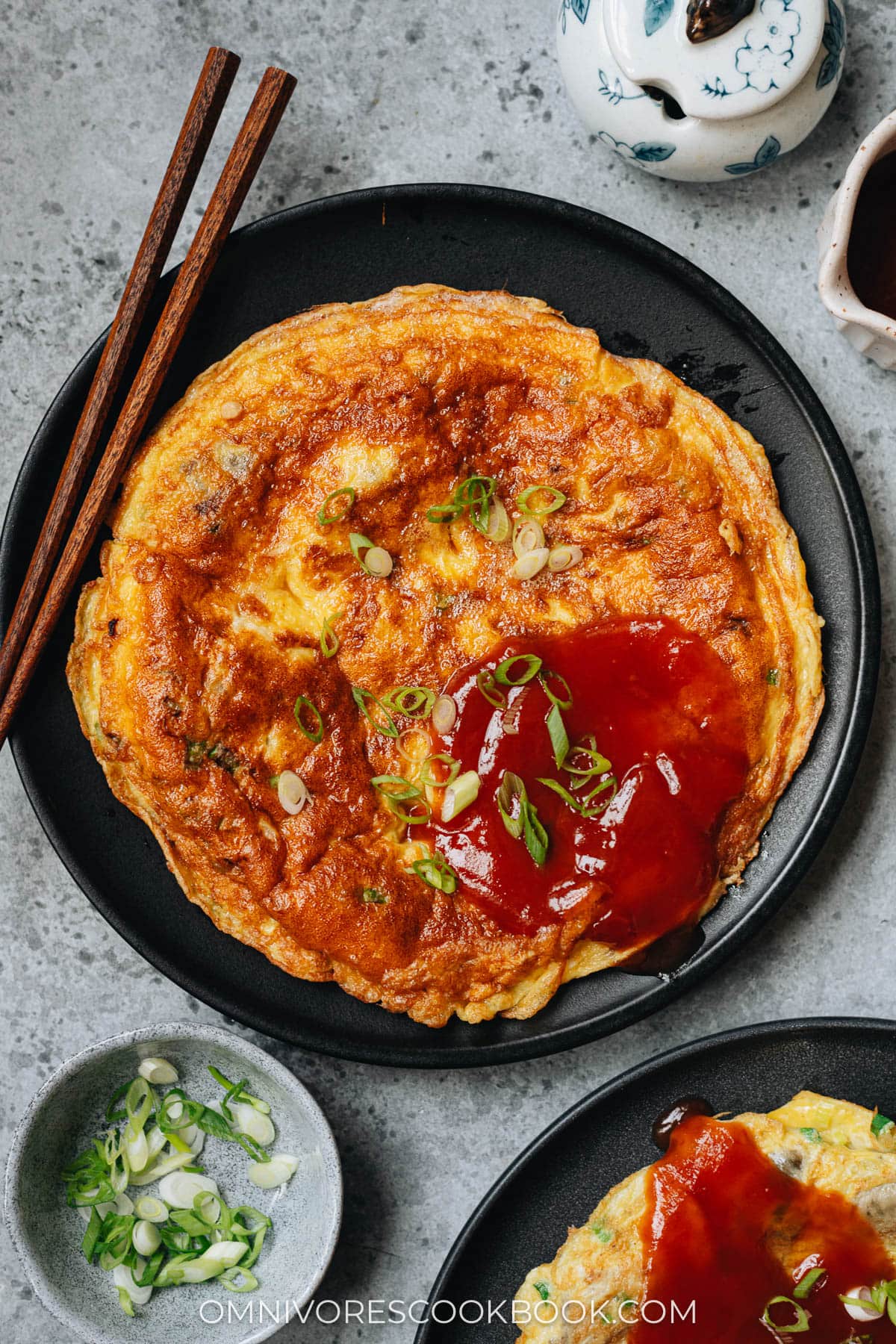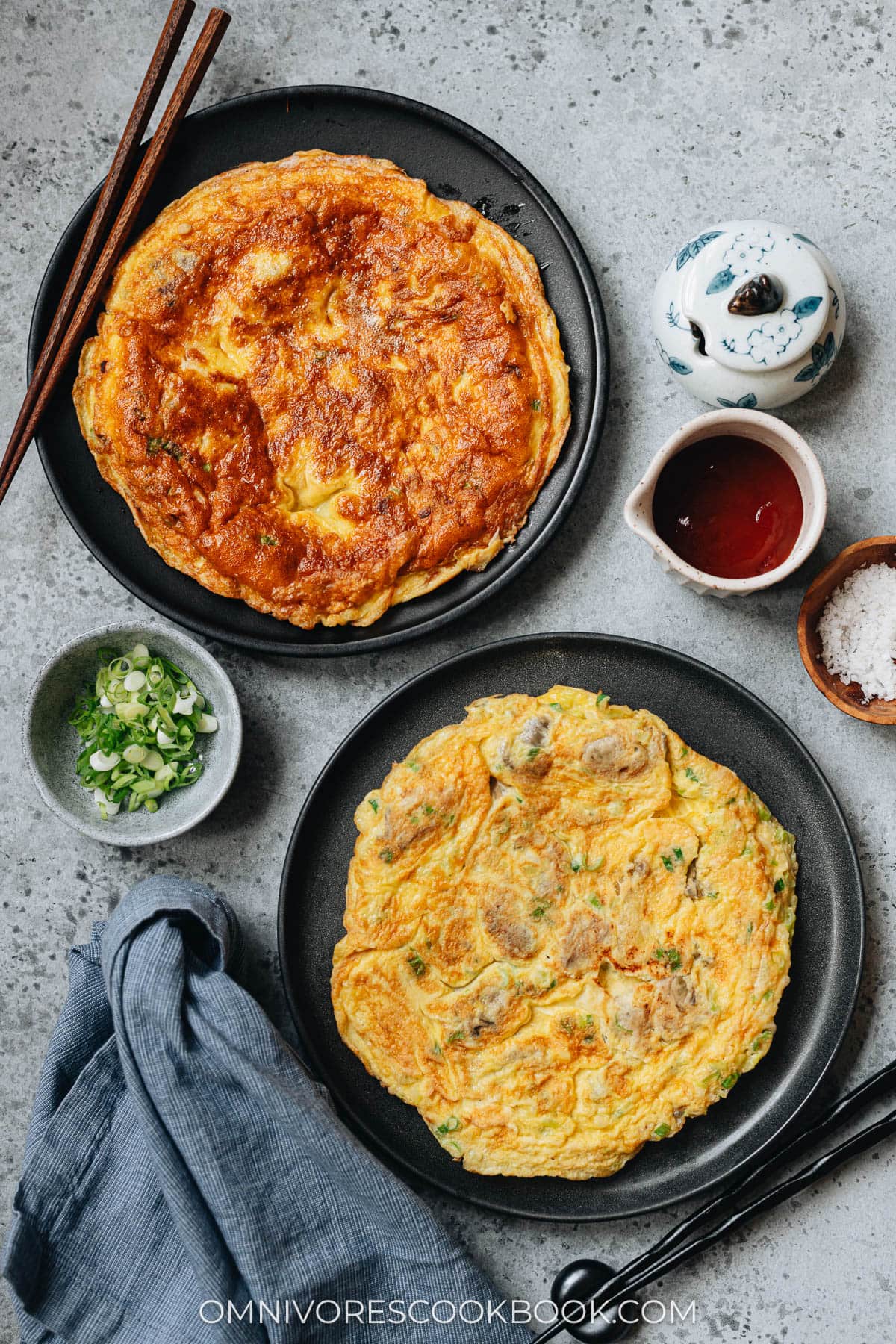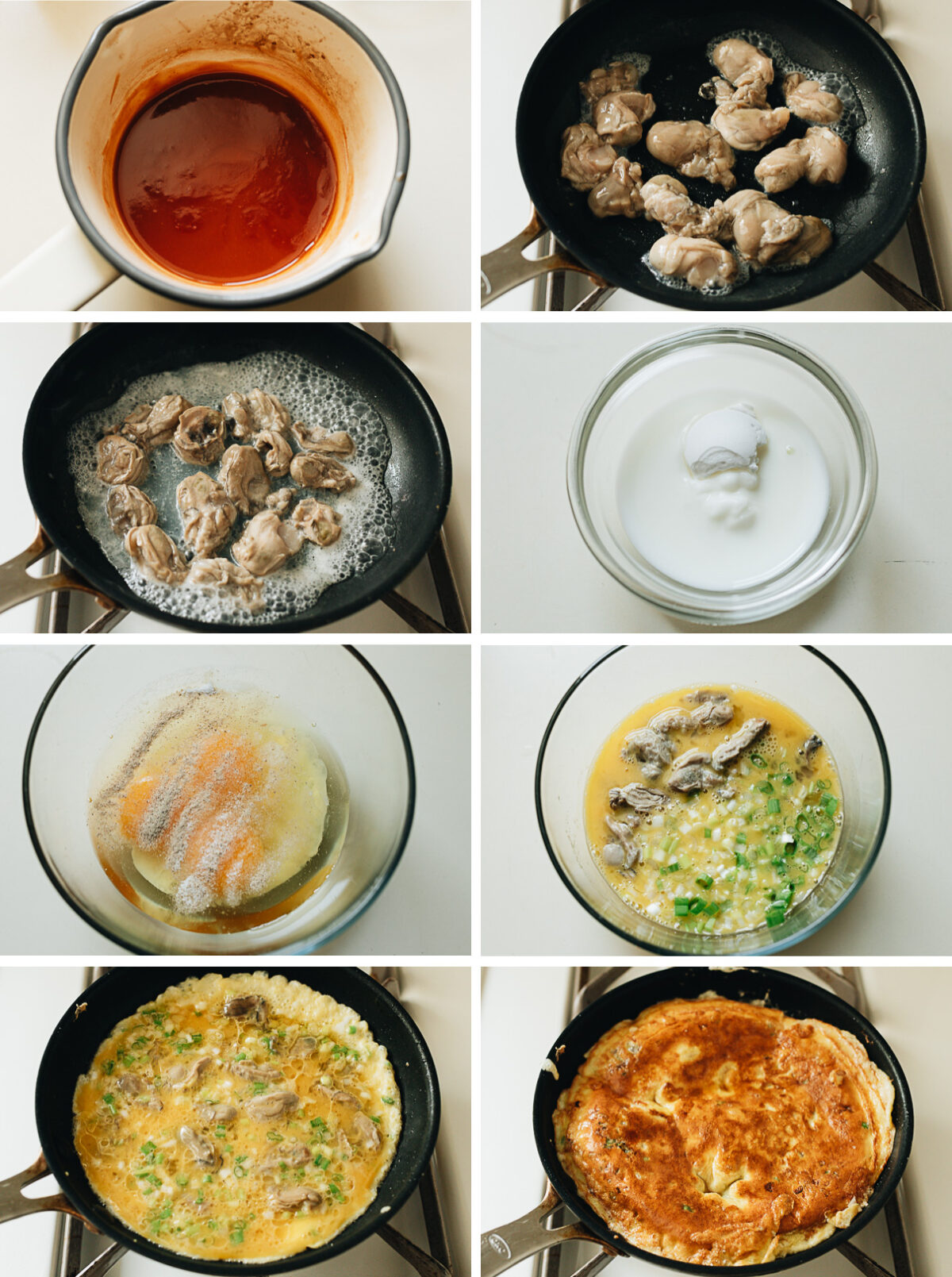
What is oyster omelet
Oyster omelet is a popular dish in various Asian cuisines, including Taiwan, Malaysia, Singapore, and many parts of mainland China. It’s a savory omelet made with fresh oysters, eggs, and a starchy batter, which gives it a slightly chewy texture.
In mainland China, the oyster omelet is known as “蚵仔煎” (Ke Zi Jian) or sometimes “海蛎煎” (Hai Li Jian), depending on the region. It is particularly popular in the coastal provinces of Fujian and Guangdong, where fresh oysters are plentiful.
Why this recipe
This oyster omelet recipe creates a result that is popular in Guangdong province. The oyster omelet is known as “蚝烙” (Hao Lao). The batter here is typically thinner, making for a crispier texture overall. Fresh oysters are mixed with egg and a small amount of starch, and the omelet is cooked until it’s golden and crispy. It is served with a sweet, tangy and savory sauce.
Compared to the oyster omelet you often find in Taiwan and Fujian province, this one has a less starchy and chewy texture by using less potato starch in the batter.

Ingredients
What type of oysters to use
For making an oyster omelet, small to medium-sized oysters with a mild, briny flavor and a plump, tender texture are ideal. Here are a few types of oysters that are well-suited for this dish:
- Kumamoto Oysters: These small, sweet oysters have a creamy texture and a mild, buttery flavor, making them a great choice for an oyster omelet.
- Pacific Oysters: These oysters are generally small to medium-sized with a sweet, briny flavor and a delicate texture. They work well in an omelet, especially when you want a more pronounced oyster taste.
- Eastern Oysters (Atlantic Oysters): These oysters have a slightly briny and savory flavor, and their medium size and firm texture make them good for cooking in an omelet.
- Blue Point Oysters: Known for their mild flavor and plump meat, Blue Point oysters are another excellent option for an oyster omelet.
No matter whether you’re shopping for oysters at a grocery store, fish market, or Chinese wet market, you can usually purchase a tub of shucked oysters for convenience.
How to prepare oysters
Before cooking, wash the oysters this way to remove any debris:
- Sprinkle some cornstarch over the oyster
- Rub the cornstarch onto oyster with your hands
- Rinse the oyster to remove the cornstarch

Mise en place
When you’re ready to cook the omelet, your table should have:
- Oysters
- Eggs
- Minced green onion
- Potato starch
- Salt and pepper
You also need a few ingredients to make the omelet sauce. But I find it easier to just mix them in the small pot and cook them directly.


How to make oyster omelet
- Mix the sauce ingredients and boil them to make a sauce
- Gently pan fry the oysters
- Transfer the oysters to a plate to cool off once cooked (discard the juice released)
- Dissolve the potato starch in the water
- Beat the eggs with salt and pepper
- Mix the dissolved potato starch, add the green onion and cooked oysters
- Pan fry the egg batter
- Cook the omelet until golden brown and cooked through
Once done, you can pour the sauce over the omelet and serve it while hot.

How to serve oyster omelet
Oyster omelet is usually sold as a street food and you can snack on it any time of day. But I really like to serve it for a weekend breakfast or brunch, to elevate your regular omelet. You can also serve it over steamed rice as a light meal. Or you can serve it as a side dish or appetizer during a multi-course dinner.

Other delicious seafood recipes
- Chinese Steamed Fish (清蒸鱼)
- Walnut Shrimp
- Cantonese Shumai with Pork and Shrimp (烧麦, Shao Mai)
- Crispy Salmon with Ginger Soy Sauce
- Spicy Squid Stir Fry (爆炒鱿鱼)
Chinese Cooking Made Easy
Are you new to this website? This free email series is a great place to start. I’ll walk you through a few of my most popular recipes and show you how and why they work. You’ll quickly start to cook better Chinese food in your own kitchen.

Oyster Omelet (蚝烙煎)
Ingredients
Sauce (*Footnote 1)
- 1/2 cup chicken broth
- 1/4 cup ketchup
- 1 tablespoon light soy sauce
- 1 tablespoon rice vinegar
- 1 tablespoon sugar
- 2 teaspoons cornstarch
Omelet
- 1/2 lb (225 g) small shucked oysters
- 2 teaspoons cornstarch
- 2 tablespoons peanut oil (or vegetable oil, divided) (*Footnote 2)
- 2 teaspoons potato starch
- 3 eggs
- 1/4 teaspoon salt
- 1/4 teaspoon white pepper
- 4 green onion , minced
Instructions
- Whisk together the sauce ingredients in a saucepan over medium-low heat. Simmer until the sauce thickens.
- Add the oysters into a colander and sprinkle evenly with cornstarch. Rub the oysters gently with the cornstarch, then use cold running water to rinse them off. This helps to clean the oysters from any shell fragments and debris. Drain thoroughly and gently pat dry with paper towels.
- Heat 1/2 tablespoon oil in a 9” skillet over medium heat until hot but not smoking hot. Add the oysters. Let cook until the bottom has turned white, 30 seconds or so. Flip to cook the other side until it just turns white. Drain off the liquid and transfer the oysters onto a plate to cool off slightly.
- Mix the potato starch with 1 tablespoon of water in a small bowl until fully dissolved.
- Beat the eggs in a large bowl with salt and white pepper. Add the potato starch slurry. Mix until fully dissolved. Add the green onion and cooled-off oysters. Mix again.
- Add the remaining 1 1/2 tablespoons of oil into the same skillet and heat over medium-high heat until hot. Pour in the egg batter and turn to medium heat. Cook until the bottom turns golden. Carefully flip the omelet. Keep cooking until the bottom has set and the inside has cooked. Transfer to a large serving plate. Serve hot along with the sauce as an appetizer or main dish.
Notes
- This recipe makes a sweet and sour omelet sauce. If you like a spicy sauce, you can also serve some of that on the side.
- It’s important to use a generous amount of oil to cook the omelet, so it creates a fluffy texture. On the other hand, if you prefer to use less oil, that is fine as well. Your omelet will be less fluffy but still taste good.
Nutrition

Did you make this recipe?
I’d love to hear how it turned out for you! Please take a moment to leave a 5-star rating ⭐️ and share your thoughts in the comments further down the page. It really helps others discover the recipe too.

John
A half pound of oysters is an awful lot for a single serving. How many oysters do you usually use?